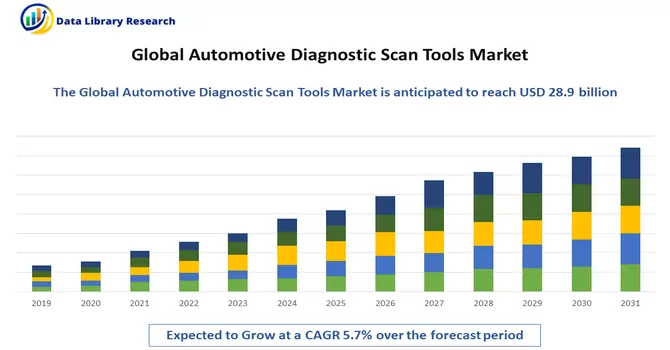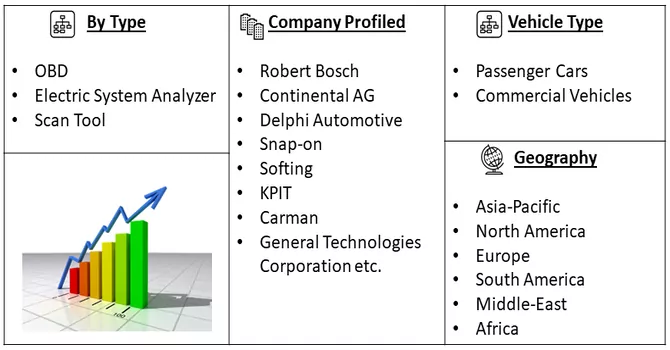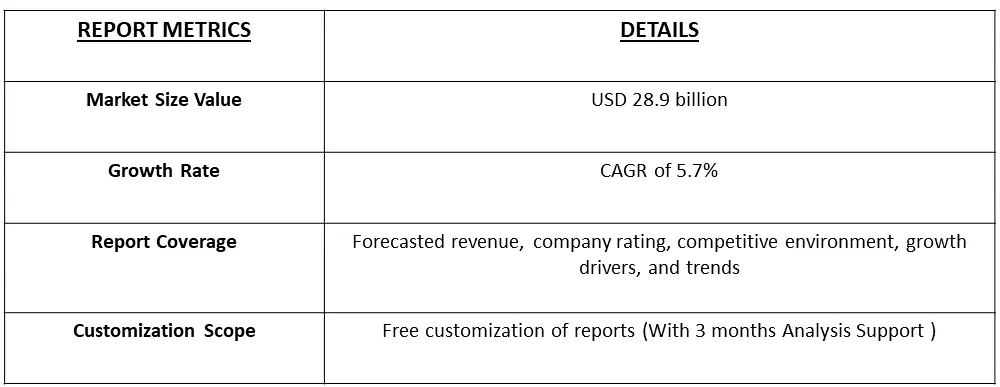In 2022, the global market size for automotive diagnostic scan tools reached USD 28.9 billion, with expectations of reaching USD 41.4 billion by 2030.

Get Complete Analysis Of The Report - Download Free Sample PDF
The Automotive Diagnostic Scan Tools Industry involves the creation, production, and distribution of specialized tools and equipment designed for diagnosing and resolving issues in vehicles. These tools are integral to contemporary automotive repair and maintenance, providing technicians and mechanics with the ability to detect and address malfunctions, errors, and performance issues in various vehicle systems. Automotive diagnostic scan tools encompass a spectrum of devices, from handheld scanners and code readers to advanced computer-based systems, enabling professionals to access, interpret, and analyze data from a vehicle's onboard computer systems.
Continuous technological advancements characterize the automotive diagnostic scan tools industry. The integration of advanced sensors, wireless connectivity, and artificial intelligence in diagnostic tools enhances their capabilities, leading to more precise and efficient identification of vehicle issues. The increasing technological complexity of modern vehicles, equipped with numerous electronic control units (ECUs) and interconnected systems, drives the demand for sophisticated diagnostic tools to accurately pinpoint and resolve issues. As vehicles evolve, so does the necessity for cutting-edge diagnostic solutions in the automotive industry.
Market Segmentation: The Automotive Diagnostic Scan Tools Market is Segmented by Type (OBD, Electric System Analyzer, and Scan Tool), Vehicle Type (Passenger Cars and Commercial Vehicles), and Geography (North America, Europe, Asia-Pacific, and Rest of the World). The Report offers the market size and forecast in value (USD billion) for all the above-mentioned segments.

For Detailed Market Segmentation - Download Free Sample PDF
There is a growing trend in the automotive diagnostic scan tools sector towards integrating artificial intelligence (AI) and machine learning features. These technological advancements enhance the tools' capacity to analyze intricate data sets, anticipate potential issues, and deliver more precise diagnostic insights. The incorporation of AI contributes to streamlined troubleshooting processes and enhances decision-making in vehicle repair. The industry is transforming wireless connectivity and cloud-based solutions for automotive diagnostic scan tools. Wireless connectivity facilitates smooth communication between diagnostic tools and vehicles, while cloud-based platforms enable remote diagnostics, software updates, and the exchange of diagnostic data across various devices and locations. This shift towards advanced connectivity solutions is ushering in a new era of efficiency and accessibility in the field of automotive diagnostics.
Market Drivers:
Growing Vehicle Complexity
The automotive diagnostic tools industry is experiencing substantial growth, driven by the escalating complexity of contemporary vehicles. The integration of advanced electronic systems, intricate onboard computers, and interconnected components has given rise to sophisticated diagnostic challenges in the automotive landscape. In response to this complexity, automotive diagnostic scan tools have emerged as crucial assets, empowering technicians to adeptly identify, interpret, and resolve issues within the intricate network of vehicle systems. The pivotal role of these tools becomes particularly evident as vehicles evolve with increasingly advanced features and technologies. As modern automobiles incorporate cutting-edge innovations, the demand for diagnostic tools capable of effectively navigating and addressing these complexities is on the rise. The automotive diagnostic scan tools industry is thus positioned at the forefront of technological advancements, providing essential solutions to meet the evolving diagnostic needs of the automotive sector in the face of advancing vehicle technologies. Thus, owing to the above-mentioned factors, the market is expected to witness significant growth over the forecast period.
Technological Advancements
The automotive diagnostic Scan tools industry is propelled forward by the persistent wave of technological advancements. The infusion of state-of-the-art technologies, including advanced sensor capabilities, wireless connectivity, and artificial intelligence, elevates the performance and effectiveness of diagnostic tools. These innovations empower technicians, providing them with the tools to conduct more precise and thorough vehicle diagnostics, thereby enhancing the speed and accuracy of issue identification. This commitment to ongoing technological progress not only caters to current diagnostic requirements but also positions the industry strategically to address the challenges posed by future developments in automotive technology. By staying at the forefront of innovation, the automotive diagnostic scan tools sector ensures its adaptability to emerging trends, ensuring its continued relevance and effectiveness in the ever-evolving landscape of automotive diagnostics. This forward-looking approach positions the industry as a key player in supporting the automotive sector through the complexities of evolving vehicle technologies. Thus, owing to the above-mentioned factors, the market is expected to witness significant growth over the forecast period.
Market Restraint:
High Initial Costs and Rapid Technological Obsolescence
One significant restraint in the automotive diagnostic scan tools industry is the high initial costs associated with advanced diagnostic equipment. The price of cutting-edge diagnostic tools with features like AI integration, wireless connectivity, and specialized capabilities can be a barrier for smaller automotive repair shops or independent technicians, limiting their ability to invest in the latest technology. The automotive industry experiences rapid technological advancements, leading to the quick obsolescence of diagnostic tools. Tools that were cutting-edge a few years ago may become outdated, requiring frequent upgrades or replacements. This dynamic landscape poses a challenge for businesses aiming to stay current with the latest diagnostic capabilities. Thus, owing to the above-mentioned factors, the market’s growth is expected to slow down over the forecast period.
The COVID-19 pandemic has left an indelible mark on various industries, including the automotive diagnostic scan tools market. The widespread disruptions caused by the pandemic, including supply chain challenges, production halts, and changes in consumer behaviour, have significantly impacted the dynamics of the automotive sector. The automotive diagnostic scan tools market, like many other industries, experienced disruptions in the supply chain. Factory closures, restrictions on transportation, and workforce shortages hampered the production and distribution of diagnostic tools, leading to delays and shortages in the market. The overall slowdown in the automotive industry, marked by reduced vehicle sales and decreased maintenance activities during lockdowns and economic uncertainties, directly affected the demand for automotive diagnostic scan tools. With fewer vehicles on the road, there was a decline in the immediate need for diagnostic and repair services. Thus, the COVID-19 pandemic presented significant challenges to the automotive diagnostic scan tools market, it also accelerated certain transformative trends. The industry's ability to adapt to the changing landscape and leverage technology for more efficient and remote diagnostics will likely shape its trajectory in the post-pandemic era.
Segmental Analysis:
Electric System Analyzer Segment is Expected to Witness Significant Growth Over the Forecast Period
The Electric System Analyzer (ESA) is a critical component within the broader automotive diagnostics scan tools market, specifically designed to address issues related to a vehicle's electrical systems. As vehicles become more electrified and incorporate complex electronic components, the demand for specialized tools like the Electric System Analyzer has increased significantly. The increasing prevalence of electric and hybrid vehicles has fueled the demand for Electric System Analyzers. These vehicles rely heavily on intricate electrical systems, making accurate diagnosis and maintenance crucial for optimal performance. The Electric System Analyzer provides technicians with the capability to assess the health of batteries, alternators, starters, and other electrical components, aiding in the early detection of potential issues. Thus, owing to such advantages, the segment is expected to witness significant growth over the studied period.
Commercial Vehicles Segment is Expected to Witness Significant Growth Over the Forecast Period
Commercial vehicles, encompassing a wide range of transport vehicles such as trucks, buses, and vans, form a crucial part of the automotive sector. The usage intensity and specific operational demands placed on commercial vehicles make automotive diagnostic tools indispensable for efficient maintenance and troubleshooting. Commercial vehicles often feature specialized systems and components tailored to their unique operational requirements. Automotive diagnostic scan tools designed for commercial use are equipped to address the distinctive challenges associated with heavy-duty engines, transmissions, and braking systems. Moreover, automotive diagnostic scan tools contribute to the efficiency and cost-effectiveness of commercial vehicle operations. By swiftly identifying and resolving issues, these tools help prevent breakdowns, minimize repair costs, and extend the lifespan of critical components. Thus, owing to such advantages, the segment is expected to witness significant growth over the studied period.
North America Region is Expected to Witness Significant Growth Over the Forecast Period
North America plays a central role in the automotive diagnostic scan tools industry, both as a significant market and a hub for technological innovation. The region's automotive landscape, characterized by a high degree of technological adoption, stringent emission standards, and a diverse vehicle market, shapes the dynamics of the automotive diagnostic scan tools sector.
North America is at the forefront of technological advancements in the automotive sector. This includes the integration of advanced electronic systems, connectivity features, and autonomous driving technologies. As vehicles become more sophisticated, the demand for cutting-edge automotive diagnostic tools rises to effectively address the complexities of modern vehicle systems. For instance, in May 2022, KPIT Technologies Ltd announced the acquisition of cloud-based vehicle diagnostics specialist SOMIT Solutions. The partnership will enable e cloud-based vehicle diagnostics platform & expert consulting services.
North America boasts a diverse vehicle market, including a mix of passenger vehicles, trucks, SUVs, and electric vehicles. Automotive diagnostic tools tailored to address the specific needs of this varied vehicle landscape are in high demand. Tools capable of diagnosing issues in both traditional internal combustion engines and electric powertrains are particularly crucial. Thus, the region is expected to witness significant growth over the forecast period.

Get Complete Analysis Of The Report - Download Free Sample PDF
The market for automotive diagnostic tools exhibits a moderate level of consolidation, attributable to the presence of both major global players and local entities. Key stakeholders in this market actively pursue diverse growth strategies, including acquisitions, partnerships, and the introduction of new products. These strategies are integral to maintaining competitiveness and expanding market presence. Several major companies play pivotal roles in shaping the landscape of the automotive diagnostic tools market. Their active engagement in strategic initiatives underscores the dynamic nature of the industry. By leveraging acquisition opportunities, these companies aim to strengthen their portfolios, enhance technological capabilities, and broaden their market reach.
Recent Development:
1) May 2023: Opus IVS, which is the leading provider of automotive diagnostic scan tools and services, announced its joint strategic partnership with CARS Co-Op Network, which is the automotive collision and repair shop. The partnership would boost the mutual growth of companies with diagnostic capabilities of the firms.
2) October 2022: Reparify has launched the new Tech all-in-one solution for local and remote automotive diagnostic, calibration, and detailed programming tools for making the repair and maintenance process of the vehicles seamless.
Q1. How big is the Automotive Diagnostic Scan Tools Market ?
The global market size for automotive diagnostic scan tools reached USD 28.9 billion, with expectations of reaching USD 41.4 billion by 2030.
Q2. What is the Growth Rate of the Automotive Diagnostic Scan Tools Market ?
Automotive Diagnostic Scan Tools Market is reaching USD 41.4 billion by 2030.
Q3. Which region has the largest share of the Automotive Diagnostic Scan Tools Market? What are the largest region's market size and growth rate?
North America has the largest share of the market. For detailed insights on the largest region's market size and growth rate request a sample here.
Q4. What segments are covered in the Automotive Diagnostic Scan Tools Market Report?
By Type, By Vehicle Type, End-User and Geography these segments are covered in the Automotive Diagnostic Scan Tools Market Report.
Data Library Research are conducted by industry experts who offer insight on industry structure, market segmentations technology assessment and competitive landscape (CL), and penetration, as well as on emerging trends. Their analysis is based on primary interviews (~ 80%) and secondary research (~ 20%) as well as years of professional expertise in their respective industries. Adding to this, by analysing historical trends and current market positions, our analysts predict where the market will be headed for the next five years. Furthermore, the varying trends of segment & categories geographically presented are also studied and the estimated based on the primary & secondary research.
In this particular report from the supply side Data Library Research has conducted primary surveys (interviews) with the key level executives (VP, CEO’s, Marketing Director, Business Development Manager and SOFT) of the companies that active & prominent as well as the midsized organization
FIGURE 1: DLR RESEARH PROCESS

Extensive primary research was conducted to gain a deeper insight of the market and industry performance. The analysis is based on both primary and secondary research as well as years of professional expertise in the respective industries.
In addition to analysing current and historical trends, our analysts predict where the market is headed over the next five years.
It varies by segment for these categories geographically presented in the list of market tables. Speaking about this particular report we have conducted primary surveys (interviews) with the key level executives (VP, CEO’s, Marketing Director, Business Development Manager and many more) of the major players active in the market.
Secondary ResearchSecondary research was mainly used to collect and identify information useful for the extensive, technical, market-oriented, and Friend’s study of the Global Extra Neutral Alcohol. It was also used to obtain key information about major players, market classification and segmentation according to the industry trends, geographical markets, and developments related to the market and technology perspectives. For this study, analysts have gathered information from various credible sources, such as annual reports, sec filings, journals, white papers, SOFT presentations, and company web sites.
Market Size EstimationBoth, top-down and bottom-up approaches were used to estimate and validate the size of the Global market and to estimate the size of various other dependent submarkets in the overall Extra Neutral Alcohol. The key players in the market were identified through secondary research and their market contributions in the respective geographies were determined through primary and secondary research.
Forecast Model
